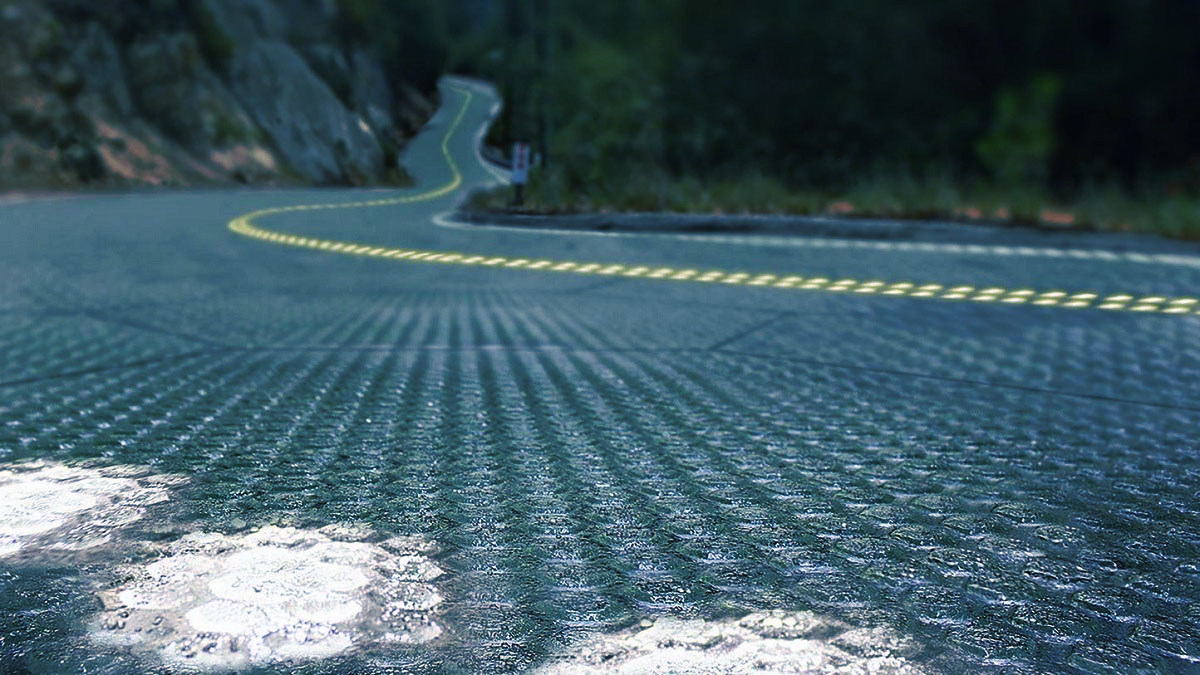

While solar roadways don’t necessarily have a direct connection to the future of cycling, after all there will always be roads, it does however, in terms of environmental impact, health and quality of life for every two-wheel junkie who views the bicycle as a means to meet that end.
Here’s a thought provoking article on the benefits of solar technology being used to create new roadways, which are energy efficient, better for the environment, foster the development of conveyances that utilize renewal, sustainable energy sources, but most importantly, promote healthier living.
article by Andrew Thomson
When we are not driving, cycling, or walking on it, a road is just a waste of space, right? Not if it is a solar road!
What a perfect combination. When it’s exposed to the sun, the road is generating clean electricity, mitigating our production of CO₂, and hence our impact on global warming.
The American Solar “freakin” Roadways is an internet phenomenon raising over US$2 million in crowd funding. They have an attractive marketing campaign and make compelling arguments for their technology. Also, the Dutch SolaRoad project has produced a 100m cycleway pilot project, which demonstrates the technical feasibility for light traffic.

Are we seeing a tipping point where the explosion in solar growth is now going to be cross-pollinated to parts of our road networks? Not likely with the concepts above.
These projects are based on PV modules made of cells and a cover glass about a centimetre thick. Without a complete technological change, it will remain a niche industry without significant impact.
Reason 1: Price
Per square metre, bitumen/asphalt roads are cheaper (around $5/m²) than centimetre thick slabs of toughened glass (around $15-20/m²), and this will not change. Asphalt is a mixture of waste products from the refining of oil, and fine gravel or aggregate. Glass, on the other hand, is formed by melting silica, and is energy intensive to produce.
Perhaps recycled glass could be used instead of refining new silica, but with a big performance hit. A centimetre of solar glass will transmit 91% of usable light; typical recycled glass will transmit only 35% (you can perform this calculation here, by comparing transmission of a centimetre thick glass substrate of green sodalime and low-fe glass).
The energy requirement of making thick solar glass is far higher than that of the glass used in standard rooftop PV. So, no matter the innovation, it will be considerably more expensive than the status quo. Does the energy generated form a solar road make up for this cost, not when you compare it to building a road and installing rooftop PV separately.
Reason 2: Performance
Roads are not orientated to face the sun. At best this is a 20% loss from traditional rooftop PV installations (see the Desert Knowledge Solar’s solar clock’s yearly performance, comparing the flat orientated system 16b to the north orientated system 16a), but it could far higher.
For example, most roads are at ground level and are easily shaded, meaning they cannot take advantage of most of the sun’s usable energy (i.e. direct sunlight). And as roads are prone to collecting dirt, this would further shade the modules.
PV panels work best when they are cool; this is why their backing is typically exposed for ventilation. It is likely that solar roads would operate at higher temperatures, further reducing their performance.
Simply put, a solar panel on a roof will perform far better than a solar road.
Reason 3: Safety
Imagine driving on a smooth glass surface, in the rain.

Road surfaces wear with use. As asphalt roads wear, layers of the fine gravel are removed, exposing further layers of rough gravel/aggregate, maintaining the surface consistency and grip.
Conversely, glass is a malleable network of homogenous material. Hence over time it wears smooth. Because of these material properties, even if the glass road surface were given a textured pattern to provide traction, it would eventually be worn away.
For real applications, where vehicles are driving over it in all weather conditions, solar roads with glass covers will not provide sufficient traction to ensure the safety of its users.
Why we need to rethink this technology
Reasons 1 and 3 are deal breakers. The key requirement of a road is that it safely and cost-effectively provides a pathway for vehicles to transport the people and materials we need to run the economy and our everyday lives. Reason 2 is important as the perceived benefit of these roads is often overstated. Sure, solar is very cost effective when compared with conventional generation in many parts of the world.
Where solar is cost effective, it is: well set up (orientation, shading, ventilation, and so on), not required to be a structural element (hence a standard module is sufficient), not displacing economic assets, and there is an electricity demand it can directly supplement.
These conditions are often well met by rooftop solar systems and small scale solar farms, they are not well met by most roadways. For solar roadways to be effective, it needs a complete technological rethink. A solution may exist, but it probably isn’t solar electric. Perhaps solar chemical reactions will come to the rescue, inspired, for example, by air cleaning pavements. For now, a road that is covered by a roof that supports solar panels, or perhaps roads that are simply lined with solar panels could suffice.
Of course, it is important to explore all alternatives for green electricity generation. But let’s not allow our excitement for a technology that appears far from viable on a large scale detract from the fact that rooftop PV is fast becoming the cheapest method of generating electricity.


